Nitrogen as fertilizer in the vineyard
Nitrogen (N) plays a major role in all grapevine physiological processes. It is considered as a macronutrient, as it is required in larger amounts than the other mineral nutrients. It controls plant vigor and its absorption by the roots is dependent on the availability of water. A nitrogen deficient grapevine will not grow well, forming short inter-nodes, chlorotic (yellow) leaves and will produce less fruits with a reduced grape N content and possible delayed maturation.
Whereas nitrogen must be available to grant an adequate growth and photosynthesis, in viticulture too much nitrogen is also detrimental. Excess vigor leads to an extended vegetative growth period and competition with grape ripening. In addition, denser canopies and higher N content in leaves can increase vulnerability to fungal diseases.
In addition to controlling vegetative vigor, nitrogen affects the composition of grapes and the activity of yeast during winemaking. Indeed, nitrogen is a key yeast nutrient needed to carry out a successful fermentation and its presence as part of complex N-compounds in musts can affect the aromatic quality of wine.
All these functions make it difficult to control and to manage nitrogen fertilization in the best way. Since 2021, Vintel Nitrogen module by ITK provides a monitoring and forecasting service that can be used on a large scale to make the best decisions concerning N fertilization in a quick and cost-effective way to attain production goals.
How do you know how much nitrogen is needed by your vineyard ?
Fertilization is a regular practice for vinegrowers, and one which demands a particular expertise to attain the optimal balance between vigor and grape composition.
This expertise is even more relevant in a world that is more and more concerned with soil and environmental preservation. Indeed, wine growers are becoming increasingly aware of the detrimental effects of excess nitrogen leaking into the environment, causing water pollution and eutrophication. For this reason, over the past decades, the application of N in vineyards has been reduced with the aim of adjusting vigor and yield while preserving the environment.
In the last decades cover cropping has made its come-back in many vineyards, after a long period in which it was abandoned, as it was considered harmful for production. Indeed, whereas using cover crops have several benefits, ranging from soil protection to the control of yield, in vineyards with low vigor, there is a concern of excessive competition for N resources with vines. In these cases, N-fertilizer application needs to be tailored to suit grapevines needs while considering the type of cover crop and its practices.
All these factors need to be considered when creating the nitrogen (N) management plan, to make the best use of N fertilizers. To conceive such plans it is very helpful to monitor vine N status and have a global vision of all the elements affecting its balance in the vineyard. A decision support tool (DST) like Vintel Nitrogen module can provide these data in real time so that nitrogen management becomes easy and effective.
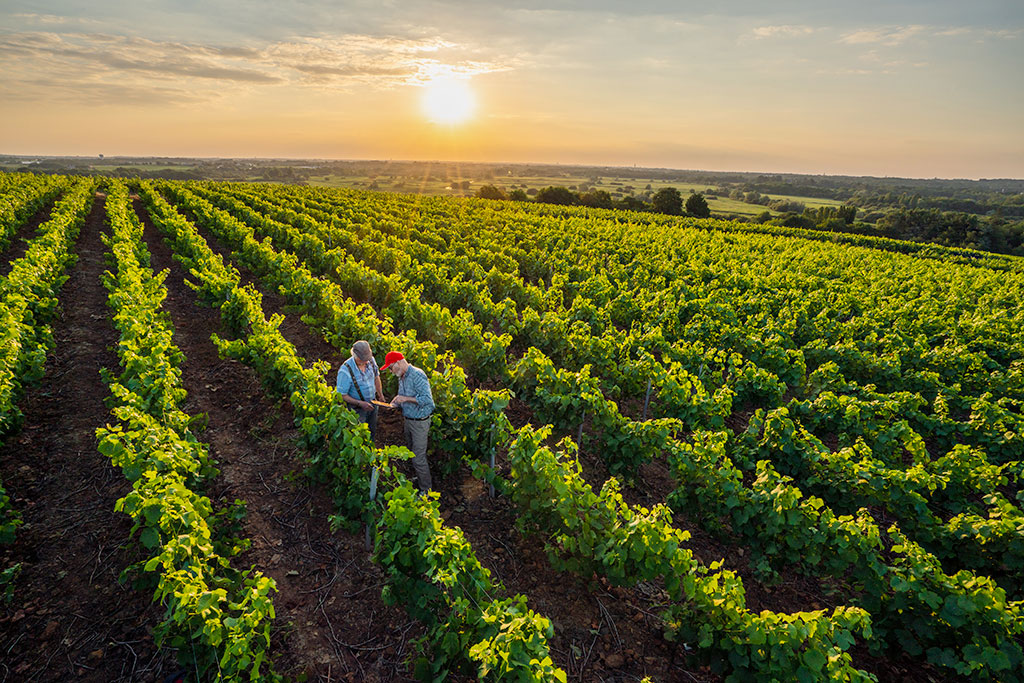
Vintel Nitrogen module predicts nitrogen availability
The new service within the Vintel DST, Nitrogen module boosts growers insight into the nitrogen status of their vineyard, informing decision-making.
This powerful solution makes it possible to visualize nitrogen stress and measure the impacts of nitrogen inputs on vine growth during the production season. And off-season it helps adjust nitrogen application so that vines maximise their reserves and can re-start growth adequately. Because Vintel Nitrogen module considers the soil-plant water balance, it allows to apply fertilizer in the right amount to avoid leaking or wash out. Moreover, the system provides a long-term weather forecast ranging several months in the future, that can help planning N purchase and application in the long term.
A nitrogen expert for winery management by the side of growers
Vintel Nitrogen module calculates daily nitrogen demands and consumption by plants, depending on nitrogen soil stocks, fertilizer application, cover cropping and other vineyard practices, and weather. This is possible because at the heart of Vintel Nitrogen module there are agronomic models of soil water balance, nitrogen mineralization and nitrogen allocation whose output provides an instant picture of your vineyard N status. Soil nitrogen dynamics over time are displayed through easy-to-interpret detailed graphs. Long-term weather forecasts allow to simulate the in season evolution of vineyard nitrogen, for a better planning of N-fertilizer applications.
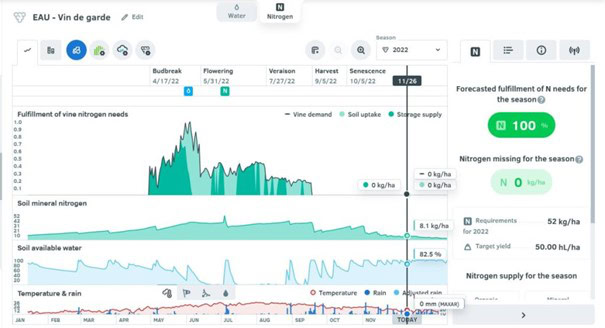
Vintel Nitrogen module : for each plot, you can visualize detailed graphs showing nitrogen demands by the plant (top), nitrogen and water availability in soil (middle) and weather (bottom)
Vintel is a complete tool for the management of nitrogen allowing growers to :
- Visualise the peaks of nitrogen consumption in their vineyard for the ongoing season.
- Know when plants are stressed and consuming their own nitrogen reserves so to avoid their depletion
- Compare different fertilization strategies to see what is their potential impact over plant nitrogen and soil stocks
- Select the best cover crop for your vineyard and optimize its management (type, planting date, removal date etc.)
- Analyze the use of nitrogen in your vineyard after harvest. Is there sufficient N for building adequate plant stocks?
- Maximize the effectiveness of N applications by considering present and future water availability in the soil
- Save money by applying just the right amount of fertilizer at the right moment.
- Preserve soil and environmental resources by avoiding excess N application and N leak into the environment
Contact us now and ask for a demo!

Summer brings new challenges for vineyards, with the appearance of various pathogens. While downy mildew is a concern in spring due to frequent rainfall, summer sees the prevalence of other harmful diseases that can impact on grape quality.
What diseases commonly affect vines in summer?
Oidium and Black Rot are two pathogens that can seriously affect leaves and bunches during growth and veraison. Powdery mildew, in particular, does not require rain or leaf wetness to develop, making it a threat even in summer, which is generally a less rainy period.Black Rot, on the other hand, poses the greatest threat to vines during the critical phenological phase between the fall of the flower caps and veraison.
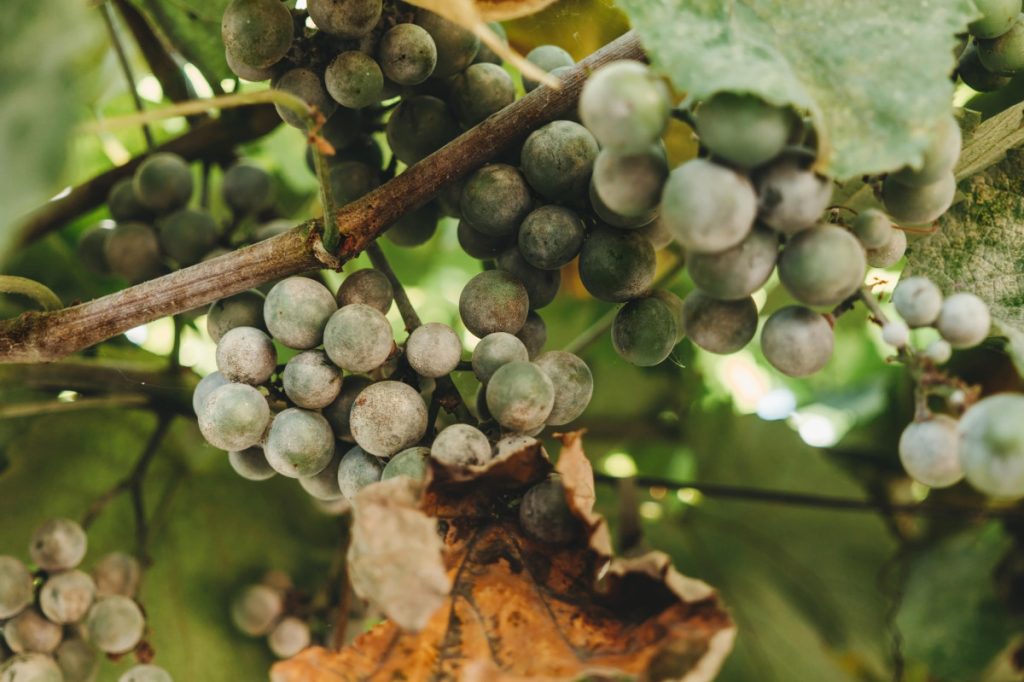
Post-veraison, grey rot, or botrytis, is particularly problematic. This fungus feeds on the sugars contained in the berries, damaging the bunches and encouraging the development of acid rot. It also imparts unpleasant odours and flavours to the wines produced.
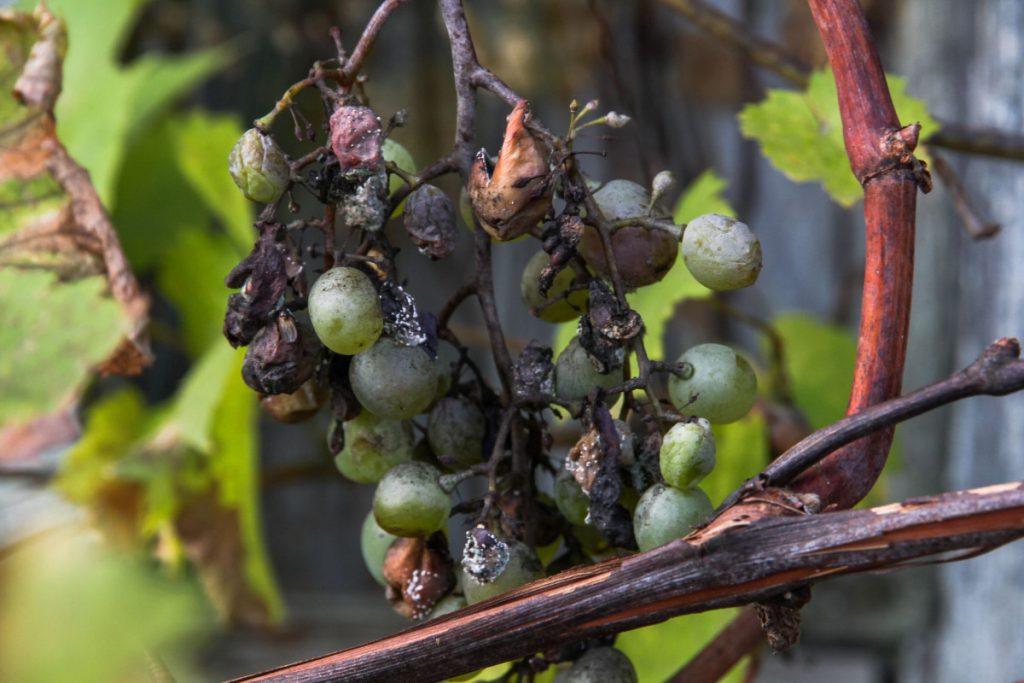
Major consequences for vineyard health and wine quality
The impact of these diseases on vineyard health can be devastating, reducing both yield and quality of the harvest. Grapes affected by these pathogens often lead to wines with undesirable aromas and tastes, far from the desired quality level.
Prevention : an effective strategy
Proactive control and prevention strategies are essential to protect vineyards from these summer diseases.
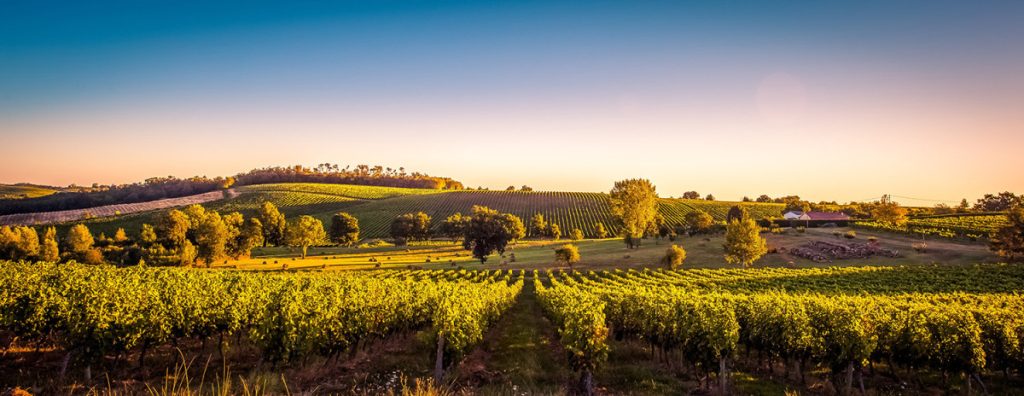
Vineyard maintenance for optimum management
It is important to select resistant grape varieties and prune properly to improve air circulation and reduce humidity, which limits the development of pathogens. Frequent inspection of the vines allows early detection of the first signs of disease. It is crucial to intervene immediately when symptoms appear to prevent the spread of disease.
The application of specific fungicides and biocontrol products, such as plant extracts or antagonistic micro-organisms, must be carried out in accordance with recommended treatment schedules or the predictions of disease DSTs (Decision Support Tools).
In the case of a plot sensitive to black rot, it is useful to use anti-mildew or anti-oidium products that also have an anti-black rot action to have a comprehensive defense strategy.
Vigilance for high-performance vineyards
Even in the drier summer months, we must not lower our guard. Vigilance and early intervention are crucial to maintaining healthy vineyards and guaranteeing high-quality wine production. Decision support systems (DSS), such as Vintel®, provide precise alerts on disease pressures. This enables winegrowers to optimise treatment timings and implement effective preventive measures, thereby enhancing vine protection and securing the future harvest against summer diseases.
Contact us now and ask for a demo!

Understanding heat waves
With climate change, prolonged heat waves are becoming more frequent and intense. It is vital for winegrowers to understand the extent of these phenomena so that they can adapt their practices and protect their vineyards.
Heat waves are periods with temperatures above 35-35°C that persist for several days. They can cause heat and water stress, affecting vine growth and grape quality.
However, it’s not just the temperature that defines a heat wave; the vapor pressure deficit (VPD) also plays a crucial role. VPD measures the difference between the amount of moisture in the air and the maximum amount the air can hold at a given temperature. A high VPD means the air is very dry, which increases the evaporation of water from the vine leaves. This leads to more intense water stress, as the vines lose water faster than they can absorb it.
These conditions of high heat and low humidity can cause both thermal and water stress, affecting vine growth and grape quality.
Identifying the risks for vineyards
Heat waves do not affect all vineyards in the same way. Different factors, such as geographical location, soil type and the age of the vines, influence the vulnerability of vineyards to these extreme conditions.
Vineyards in the Mediterranean or in arid regions are at greater risk.
Soils poor in organic matter, such as light and sandy soils can weaken plants. Young or poorly rooted vines are also more vulnerable.
What impact do high temperatures on vines?
High temperatures can have a variety of, often negative, effects on vines. It is crucial to understand these impacts to adopt effective management strategies.
High temperatures contribute to stomatal closure, reducing photosynthesis and metabolic processes. Another impact is the acceleration of ripening, which can lead to over-ripening of the grapes. Finally, high temperatures can lead to undesirable changes in the chemical composition of the grapes, altering the sugar/acid balance and, ultimately, the taste of your wine. These effects are mainly due to the breakdown of organic acids and an increase in sugar levels, resulting in wines that lack ‘freshness’ and have higher alcohol contents.
In fact, high temperatures accelerate respiration and gluconeogenesis, processes that consume the malic acid accumulated during fruit ripening. Heat waves can also impact wine aromas. These are derived from various volatile compounds that are influenced by the growing conditions of the grapes. Heat can alter the concentration and profile of these aromatic compounds, affecting the bouquet and complexity of the final wine. Anthocyanines are also negatively affected by high temperatures, resulting in lighter colouring red wines.
Heat damage
Beyond direct heat stress, hot weather can cause various types of damages in vineyards. Proactive management is to minimising these risks.
Grape berries exposed to direct sunlight can suffer significant damage. High temperatures can cause sunburn, which manifests itself as brown and necrotic spots on the berries and results in dried up berries and leaves. This damage can not only reduce the quality of the fruit but also increase its susceptibility to infection and disease.
Water stress is another crucial factor linked to high temperatures. When exposed to these conditions, vines need more water to maintain their physiological functions. Without adequate irrigation, this can lead to excessive water stress. Lack of water can reduce photosynthesis, slow growth and decrease sugar production in the berries.
Heat stress can also disrupt the absorption of nutrients by the vines. For example, the absorption of nitrogen, an essential element for plant growth and development, can be significantly reduced as a result of heat stress, especially when the soil is dry. This nutritional deficiency can weaken vines, making them more vulnerable to disease and reducing their ability to produce high-quality grapes.
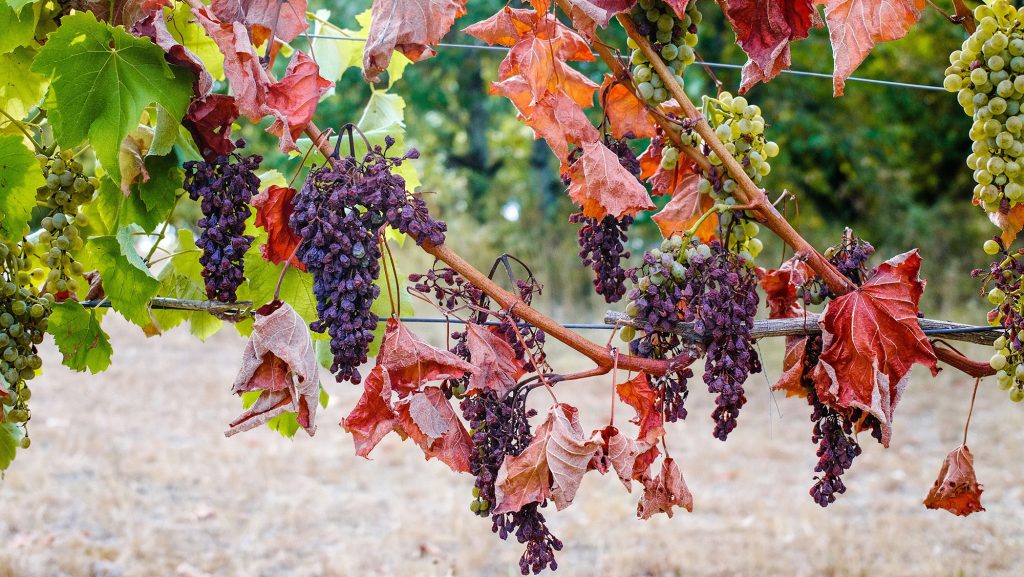
What strategies can be used to protect vineyards from heat peaks ?
Fortunately, there are several strategies you can implement to protect your vineyard from the effects of heat waves. Adopting appropriate practices can help to maintain the health of the vines and the quality of production.
- Targeted irrigation: Irrigate in large quantities and less frequently, to encourage the roots to go deeper into the soil. Pre-irrigating before a heatwave to
- Adjust phytosanitary treatments: Avoid treatments withsulphur, terpenes or essential oils during high heat and sunny conditions, as they can cause burns.
- Canopy management: Prune and orientate your vines to maximise shade on the grapes. Favour an east-west orientation to reduce the exposure of the bunches.
- Mulching: Use mulch to retain soil moisture and reduce evaporation.
- Cover crop: Mow the canopy between the rows but do not leave the soil bare.
Embrace technology
Modern technology can be a huge help in managing your vineyard during heat waves. Decision Support Tools like Vintel® provide alerts and irrigation advice tailored to heat events, helping you stay proactive.
By understanding and applying these strategies, winegrowers can better protect their vineyards from the harmful effects of heat waves and maintain the quality of their production.
For more information, please contact us: Vintel® » Contact us | Vintel® (vintel-itk.com)
Contact us now and ask for a demo!

This year 2024, French vineyards are experiencing an unprecedented level of powdery mildew pressure. Vines were hit by early contaminations starting in late March, owing to early phenology and mild, wet weather. Such an early onset of attack is exceptional in this regionWeather conditions in April and May, marked by heavy rainfall, exacerbated the situation, making disease management particularly difficult. While some regions are beginning to benefit from drier weather, allowing better control of the disease, the importance of vigilance and effective application of treatments remains crucial to limit damages.
Downy mildew, a significant impact on plants and yields
Downy mildew, caused by the pathogen Plasmopara viticola, attacks various parts of the vine: leaves, bunches and berries. This disease has several negative effects:
It reduces the leaf surface used for photosynthesis. Affected leaves exhibit oily yellow spots on their upper surface and white mold on their underside.
It damages the berries turning them brown and crushed, consequently decreasing the quality and yield of the harvest.
It weakens the shoots, preventing shoot development and wood formation, making winter pruning more difficult. These combined effects reduce the vine’s reserves, compromise berry growth and make the plants more vulnerable.
What conditions are conducive to risk?
The development of downy mildew is favoured by specific climatic conditions:
Ideal temperatures for the spread of the disease are between 20 and 25°C with a humidity level of 85% or more.
Prolonged rainfall, dew and morning fog exacerbate the risk of contamination.
Periods of vigorous vine growth, when new shoots are most vulnerable, are particularly critical. In addition, certain grape varieties, such as Cabernet Franc, Cabernet Sauvignon, Chardonnay and Merlot, are particularly sensitive to mildew.

Appropriate treatment and prevention methods
Copper-based fungicides and specific systemic products are commonly used to combat downy mildew. It is essential to alternate the types of fungicide used to prevent the pathogen from developing resistance. In addition, combining substances with different modes of action and creating spatial heterogeneity in their application helps to prevent the development of pathogen resistance.
Various cultivation techniques can prevent downy mildew, such as pruning to improve air circulation around the plants, removing infected debris to reduce sources of contamination, and ensuring effective drainage to avoid puddle formation. Green pruning eliminates unnecessary shoots and promotes shoot aeration; maintaining a cover crop protects the soil and reduces water or contaminated soil splashes. Trellising and leaf removal also improve aeration. Finally, controlling plant vigour by limiting fertilization prevents excessive growth, which is conducive to powdery mildew.
Protecting vines effictively
For an effective protection against downy mildew, it is essential to follow reliable weather forecasts when planning treatments, to avoid water stagnation around the plants, and, in years with high disease pressure, to ensure a continuous phytosanitary protection without excessively long intervals between treatments. It is also important to regularly check the functionality and efficiency of sprayers, and to use decision-support systems such as Vintel to receive risk alerts on downy mildew and other diseases
Proactive, well-informed management is key to effective powdery mildew control. By combining different strategies, winegrowers can protect their vines and ensure the quality of their harvest inspite of the challenges posed by the unfavourable climate conditions of 2024.
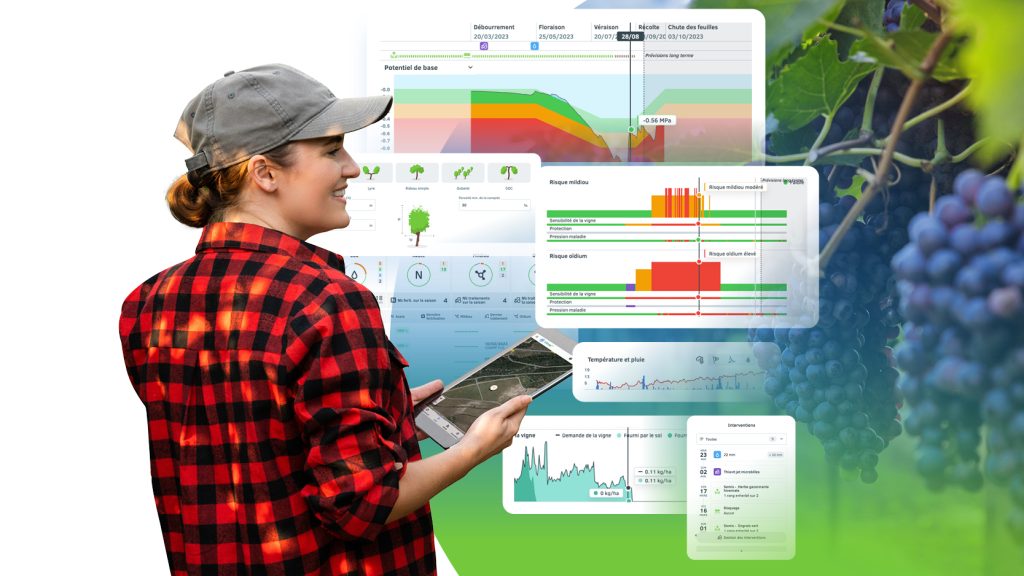
With the arrival of spring comes the opportunity to prepare your vines for a fertile season. Why is vine nutrition crucial from the start of the season? What role does nitrogen play in this delicate equation between growth and fruit quality? Let’s discover the keys to a successful wine-growing season.
Ensuring optimal nutrition from the start of the season
Pour optimiser votre saison viticole, il est essentiel de fournir dès le début un apport nutritionnel stratégique aux vignes. Un apport nutritionnel adéquat avant la floraison favorise une croissance saine et vigoureuse, assurant les bases d’une récolte de qualité. Un apport nutritif précoce, particulièrement s’il garantit l’équilibre optimal des éléments majeurs et des oligo-éléments, est stratégique car il favorise un développement racinaire sain, une floraison optimale, renforce la résistance aux stress environnementaux et contribue à produire une récolte de haute qualité. Tout déséquilibre pourrait conduire à des pertes de rendements ou un impact sur la qualité du vin.
Controlling the ideal amount of nitrogen
Nitrogen, the nutrient that most influences yield, is essential for vine growth, but finding the right balance is a challenge. Low nitrogen levels can limit fruit growth, while too high a level can lead to excessive vegetation and the risk of disease.
According to IFV, recommended nitrogen doses generally range from 30 to 60 kg N/ha for production of 6 to 10 t/ha, and 60 to 90 kg N/ha for production of 10 to 25 t/ha.
L’absorption de l’azote se déroule principalement en trois phases : la première se produit pendant et peu après la floraison. L’azote absorbé est alors principalement utilisé pour la croissance végétative. Une deuxième phase a lieu pendant la véraison, période durant laquelle l’azote absorbé enrichit principalement les baies. Enfin, une troisième phase intervient après les vendanges, si les conditions climatiques le permettent. L’azote absorbé est alors stocké dans les parties pérennes de la vigne.
Il est donc crucial de planifier la fertilisation de manière que la bonne quantité d’azote soit disponible pendant ces périodes critiques. Vous maximisez ainsi la santé de vos vignes et garantissez la qualité de votre récolte, en favorisant une croissance équilibrée et une maturation optimale.
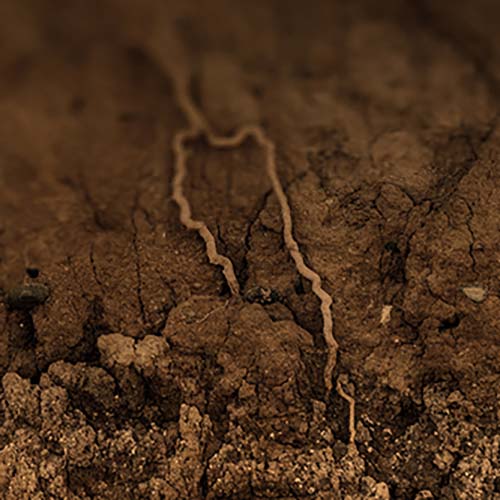
Nitrogen, the driving force behind vine growth and quality
In addition to its crucial role in vine growth, nitrogen plays a decisive role in fermentation and wine quality. During alcoholic fermentation, nitrogen is used by yeast to metabolize sugars into alcohol and other aromatic compounds. An adequate supply of nitrogen promotes more complete fermentation, contributing to the production of higher-quality wines.
De plus, l’azote est essentiel pour la synthèse des protéines dans les baies, ce qui influence directement la composition du moût et, par conséquent, les caractéristiques organoleptiques du vin final. Un bon apport d’azote favorise la production de mouts plus riches en acides aminés, en protéines et en enzymes, éléments clés pour obtenir des vins équilibrés, aromatiques et dotés d’une texture plus complexe.
By ensuring optimal nitrogen supply throughout the vine’s growth cycle, winegrowers can significantly improve the quality of their harvest and produce exceptional wines.
Our experts anticipate nitrogen competition
Le cycle de l’azote est complexe et les facteurs de compétition azotée pour les cultures, nombreux, mais cette compétition peut être anticipée afin de maximiser la biodisponibilité de l’azote pour la vigne. Nos experts calculent avec précision le dosage d’azote nécessaire, en tenant compte du couvert végétal et du type d’engrais utilisé, pour une disponibilité optimale des nutriments dans le sol. Piloter votre fertilisation azotée et maîtriser les facteurs de compétition permet d’assurer la productivité et la santé de votre vignoble de manière durable.
Our digital tools for intelligent fertilization
Optimisez votre gestion de la fertilisation avec nos outils numériques avancés !
La modélisation des dynamiques de l’azote vous permet de prendre des décisions éclairées pour une croissance et une qualité optimale de votre vignoble. La solution Vintel permet de simplifier votre quotidien et d’optimiser vos performances techniques et économiques.
Préparez-vous dès maintenant pour une saison fructueuse avec une fertilisation optimisée et nos outils numériques innovants. Contactez-nous pour maximiser le rendement et la qualité de votre vignoble : Vintel®
Do you want to try a complete decision-making tool?
Grapevines are particularly vulnerable to diverse fungal pests and insects. High susceptibility to biotic stress of grape varieties can lead to important economic losses, reduction of wine quality and undesirable sensory characteristics.
Over time, the high disease pressure and lack of genetically resistant cultivars have encouraged the use of large amounts of pesticides in vineyards to preserve yields and quality. Every year, around 2 million tons of different pesticides are used worldwide, and this amount is predicted to rise with the increase of disease resistance.
However phytosanitary treatments should be carefully planned by selecting the optimal timing for application and determining the type and dosage of chemicals to be used. This approach aims at minimizing the environmental and human health impacts while reducing the overall phytosanitary costs forgrowers.
When are vines at risk of disease?
It is crucial to precisely evaluate the current disease risk by integrating various pieces of information. This integration can be exemplified though the disease triangle, a well-established concept in plant pathology. According to this conceptual model, the actual development of a disease requires the simultaneous presence of three critical factors: a susceptible host, a virulent pathogen, and an environment conducive to disease development.
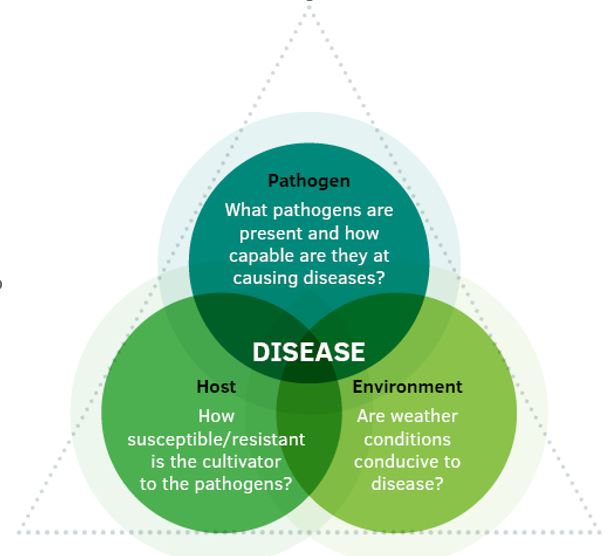
While it’s generally easy to determine the presence of a pathogen in a given region, assessing plant susceptibility and climatic propensity to disease can be more complex. Each disease reacts to specific weather conditions and attacks the plant during specific windows of vulnerability, often associated with particular phenological phases. For example, grapevines are susceptible to powdery mildew from the stage when the leaves are half-spread to the stage when the berries become resistant to penetration by the fungus, before the ripening process begins. So, to assess the real risk of disease, it is necessary to take into account not only the impact of weather conditions on powdery mildew, but also the vulnerability of vines at different phenological stages.
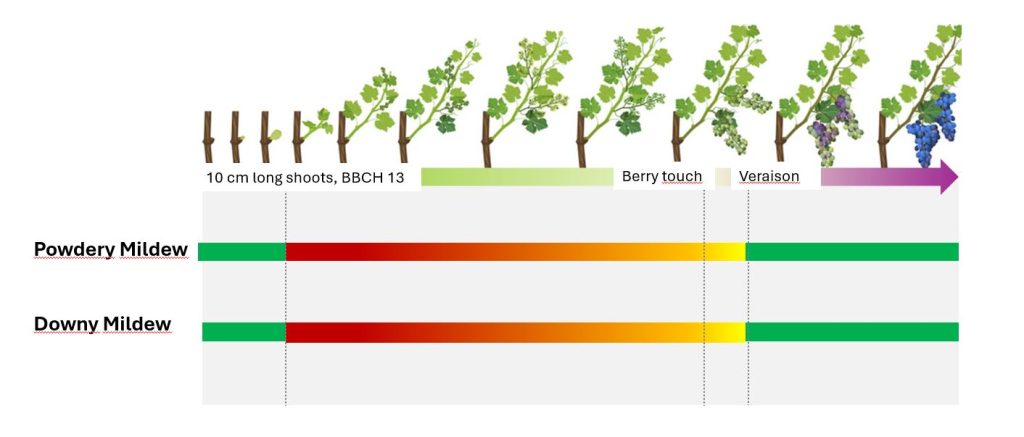
Predicting plant-environment-pathogen interactions and treatment efficacy
The complexity of plant-environment-pathogen interactions can pose challenges in evaluating actual disease risk and making rapid, effective phytosanitary decisions. To address these issues, precision viticulture utilizes tools that simultaneously consider all contributing factors. One effective approach is the integration of plant phenological models with disease models within a Decision Support System (DSS).
This method involves simulating the interaction between disease development and plant vulnerability. This combined modeling approach allows an accurate assessment of risk by aligning the various stages of disease progression with susceptible phenology. The resulting information facilitates more targeted and timely interventions, enhancing the effectiveness of disease management in vineyards.
Furthermore, model based DSS can predict the duration of treatment efficacy and the likelihood of wash-off if rain occurs. This means that treatment renewal is no longer a matter of speculation but based on more empirical grounds. Excess applications are avoided because growers know the protection level of their plants and can therefore save money and decrease environmental impacts while maintaining vineyard health, grape quality, and ultimately increase their profitability.
The key to a successful protection strategy: Anticipating risk
Finally, DSS offer the benefit of forecasting imminent risks using weather. Planning treatments in advance is essential to guarantee sufficient protection, especially considering that phytosanitary products for fungal diseases primarily act preventively rather than curatively. Sometimes a few days of advance can make a huge difference on final disease levels and save the yield.
The case of Italy in 2023: When experience is not enough
For example, in 2023, an unusually wet start to the growing season in southern and central Italy led to a devastating outbreak of downy mildew. The combination of frequent rain and warm temperatures in May and June created ideal conditions for fungal growth in regions where such diseases were historically rare, resulting in significant yield losses.
Many growers reacted slowly because they underestimated the risk, assuming their vineyards were historically less prone to disease. Consequently, they initiated treatments too late, unable to contain the infections in time.
In such situations, the integration of DSS, offering predictive insights into disease risk, proves invaluable for formulating effective phytosanitary strategies to protect yield. As climate-change driven disruptions become more frequent, growers will increasingly struggle to rely solely on past experiences to predict risks. Thus, the significance of predictive tools like those described will only grow more evident as time progresses.
If you’d like to find out more about Vintel and its disease module, click here for a free trial.

